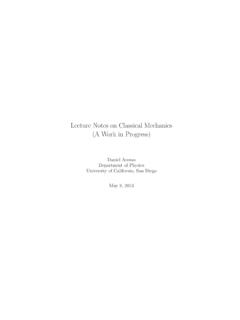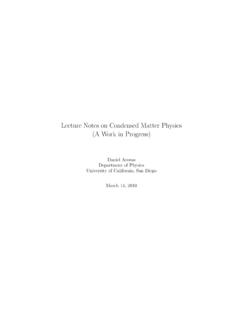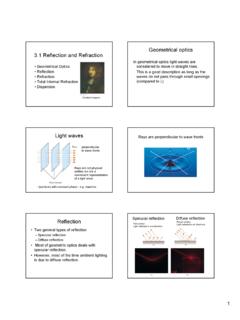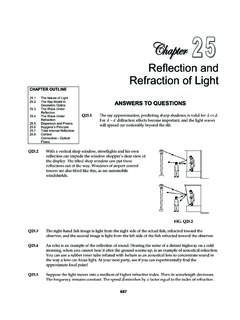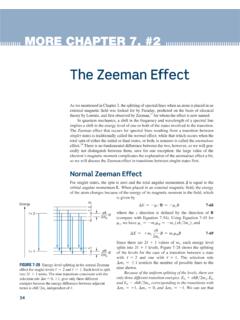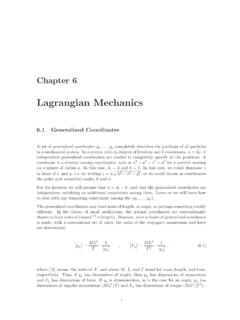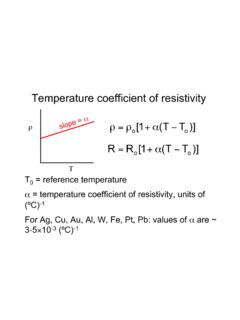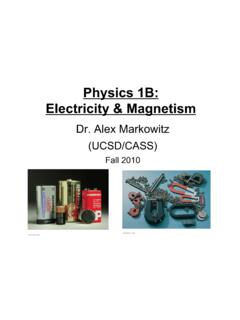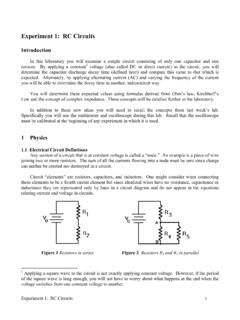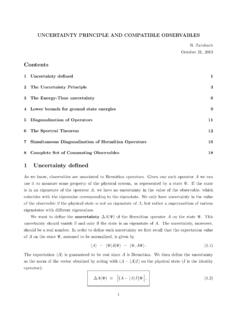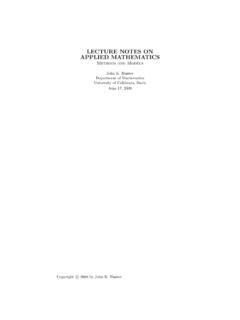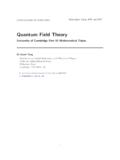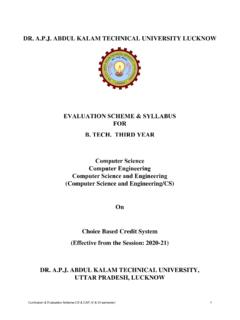Transcription of Lecture Notes on Superconductivity (A Work in Progress)
1 Lecture Notes on Superconductivity (A Work in Progress). Daniel Arovas Congjun Wu Department of Physics University of California, San Diego June 23, 2019. Contents 0 References 1. General Texts .. 1. Organic Superconductors .. 2. Unconventional Superconductors .. 2. Superconducting Devices .. 2. 1 Phenomenological Theories of Superconductivity 3. Basic Phenomenology of Superconductors .. 3. Thermodynamics of Superconductors .. 5. London Theory .. 8. Ginzburg-Landau Theory .. 11. Landau theory for superconductors .. 12. Ginzburg-Landau Theory .. 13. Equations of motion .. 13. Critical current .. 14. Ginzburg criterion .. 15. Domain wall solution .. 17.
2 Scaled Ginzburg-Landau equations .. 18. Applications of Ginzburg-Landau Theory .. 19. Domain wall energy .. 19. Thin type-I films : critical field strength .. 21. Critical current of a wire .. 24. Magnetic properties of type-II superconductors .. 26. i ii CONTENTS. Lower critical field .. 27. Abrikosov vortex lattice .. 28. 2 Response, Resonance, and the Electron Gas 33. Response and Resonance .. 33. Energy Dissipation .. 35. Kramers-Kronig Relations .. 35. Quantum Mechanical Response Functions .. 37. Spectral Representation .. 39. Energy Dissipation .. 40. Correlation Functions .. 41. Continuous Systems .. 42. Density-Density Correlations .. 42. Sum Rules.
3 43. Structure Factor for the Electron Gas .. 45. Explicit T = 0 Calculation .. 45. Screening and Dielectric Response .. 49. Definition of the Charge Response Functions .. 49. Static Screening: Thomas-Fermi Approximation .. 50. High Frequency Behavior of (q, ) .. 52. Random Phase Approximation (RPA) .. 53. Plasmons .. 54. Jellium .. 55. Electromagnetic Response .. 57. Gauge Invariance and Charge Conservation .. 58. A Sum Rule .. 59. Longitudinal and Transverse Response .. 59. Neutral Systems .. 60. The Meissner Effect and Superfluid Density .. 61. Electron-phonon Hamiltonian .. 63. 3 BCS Theory of Superconductivity 65. CONTENTS iii Binding and Dimensionality.
4 65. Cooper's Problem .. 66. Effective attraction due to phonons .. 70. Electron-phonon Hamiltonian .. 70. Effective interaction between electrons .. 71. Reduced BCS Hamiltonian .. 72. Solution of the mean field Hamiltonian .. 73. Self-consistency .. 75. Solution at zero temperature .. 76. Condensation energy .. 77. Coherence factors and quasiparticle energies .. 77. Number and Phase .. 79. Finite temperature .. 79. Isotope effect .. 80. Landau free energy of a superconductor .. 80. Paramagnetic Susceptibility .. 84. Finite Momentum Condensate .. 84. Gap equation for finite momentum condensate .. 86. Supercurrent .. 86. Effect of repulsive interactions.
5 87. Appendix I : General Variational Formulation .. 89. Appendix II : Superconducting Free Energy .. 90. 4 Applications of BCS Theory 93. Quantum XY Model for Granular Superconductors .. 93. No disorder .. 94. Self-consistent harmonic approximation .. 94. Calculation of the Cooper pair hopping amplitude .. 97. Tunneling .. 98. Perturbation theory .. 98. The single particle tunneling current IN .. 100. iv CONTENTS. The Josephson pair tunneling current IJ .. 106. The Josephson Effect .. 109. Two grain junction .. 109. Effect of in-plane magnetic field .. 110. Two-point quantum interferometer .. 110. RCSJ Model .. 111. Ultrasonic Attenuation .. 121. Nuclear Magnetic Relaxation.
6 123. General Theory of BCS Linear Response .. 125. Case I and case II probes .. 127. Electromagnetic absorption .. 129. Electromagnetic Response of Superconductors .. 131. Chapter 0. References No one book contains all the relevant material. Here I list several resources, arranged by topic. My personal favorites are marked with a diamond ( ). General Texts P. G. De Gennes, Superconductivity of Metals and Alloys (Westview Press, 1999). M. Tinkham, Introduction to Superconductivity (2nd Edition) (Dover, 2004). A. A. Abrikosov, Fundamentals of the Theory of Metals (North-Holland, 1988). J. R. Schrieffer, Theory of Superconductivity (Perseus Books, 1999).
7 T. Tsuneto, Superconductivity and Superfluidity (Cambridge, 1999). J. B. Ketterson and S. N. Song, Superconductivity (Cambridge, 1999). J. F. Annett, Superconductivity , Superfluids, and Condensates (Oxford, 2004). M. Crisan, Theory of Superconductivity (World Scientific, 1989). Levy, Magnetism and Superconductivity (Springer, 2000). 1. 2 CHAPTER 0. REFERENCES. Organic Superconductors T. Ishiguro, K. Yamaji, and G. Saito, Organic Superconductors (2nd Edition) (Springer, 1998). Unconventional Superconductors V. P. Mineev and K. Samokhin Introduction to Unconventional Superconductivity (CRC Press, 1989). M. Yu Kagan, Modern Trends in Superconductivity and Superfluidity (Springer, 2013).
8 G. Goll, Unconventional Superconductors : Experimental Investigation of the Order Parameter Symmetry (Springer, 2010). E. Bauer and M. Sigrist, Non-Centrosymmetric Superconductors : Introduction and Overview (Springer, 2012). Superconducting Devices K. Likharev, Dynamics of Josephson Junctions and Circuits (CRC Press, 1986). S. T. Ruggiero and D. A. Rudman, Superconducting Devices (Academic Press, 1990). Chapter 1. Phenomenological Theories of Superconductivity Basic Phenomenology of Superconductors The superconducting state is a phase of matter, as is ferromagnetism, metallicity, etc. The phenomenon was dis- covered in the Spring of 1911 by the Dutch physicist H.
9 Kamerlingh Onnes, who observed an abrupt vanishing of the resistivity of solid mercury at T = K1 . Under ambient pressure, there are 33 elemental superconductors2 , all of which have a metallic phase at higher temperatures, and hundreds of compounds and alloys which exhibit the phenomenon. A timeline of superconductors and their critical temperatures is provided in Fig. The related phenomenon of superfluidity was first discovered in liquid helium below T = K, at atmospheric pressure, independently in 1937 by P. Kapitza (Moscow) and by J. F. Allen and A. D. Misener (Cambridge). At some level, a superconductor may be considered as a charged superfluid we will elaborate on this statement later on.
10 Here we recite the basic phenomenology of superconductors: Vanishing electrical resistance : The DC electrical resistance at zero magnetic field vanishes in the super- conducting state. This is established in some materials to better than one part in 1015 of the normal state resistance. Above the critical temperature Tc , the DC resistivity at H = 0 is finite. The AC resistivity remains zero up to a critical frequency, c = 2 /~, where is the gap in the electronic excitation spectrum. The frequency threshold is 2 because the superconducting condensate is made up of electron pairs, so breaking a pair results in two quasiparticles, each with energy or greater.
